Green Cosmetics: The Push for Sustainable Beauty
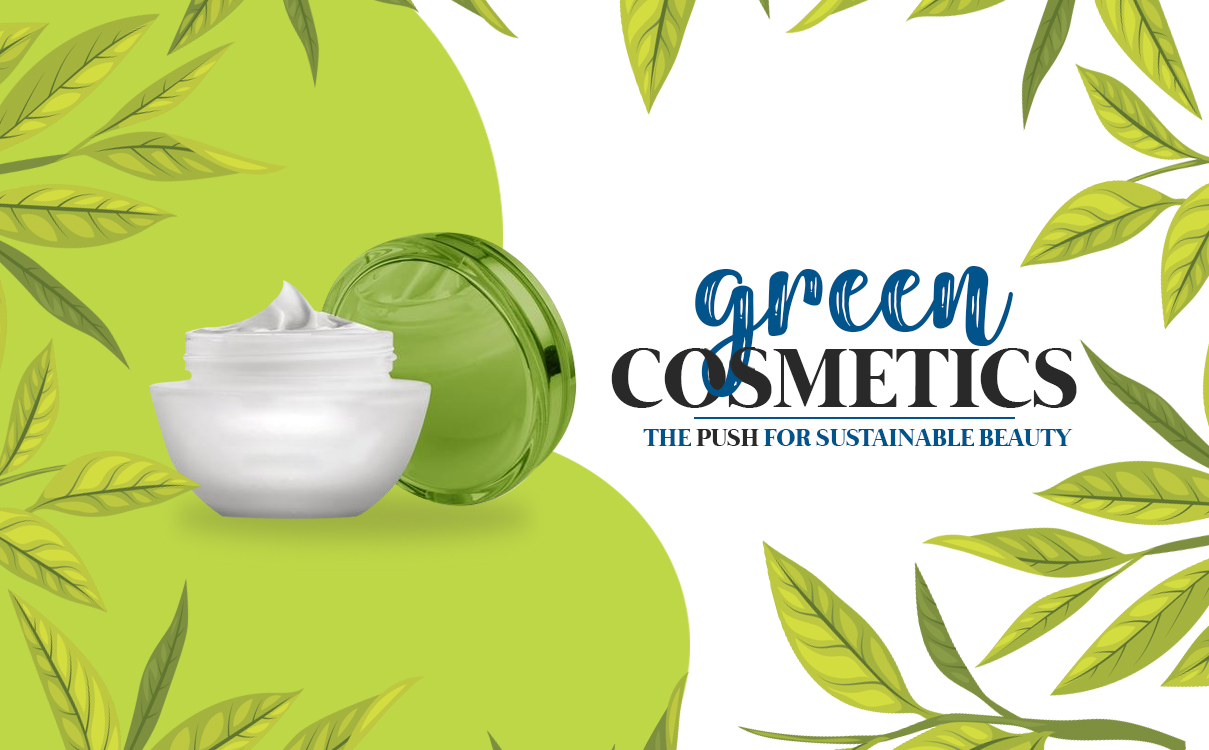
Jump to:
- What Are Green Cosmetics?
- How Are Sustainable Cosmetics Made?
- Ingredients That Aren’t Sustainable
- Examples Of Sustainable Skin Care and Cosmetics
- Why Buy Natural and Sustainable Cosmetics
- Why Produce Green Cosmetics?
- The Future of Sustainable Cosmetics
- Start Going Green
More than ever before, consumers aren’t interested in your product — they’re interested in your process.
As public interest in sustainability continues to climb, many cosmetic manufacturers are seeking more natural and environmentally-friendly emulsifiers and ingredients for their products. The benefits of “green” beauty products extend beyond trends — increasing studies show the toxicity of conventional cosmetics, and the natural cosmetics market continues to grow rapidly and consistently.
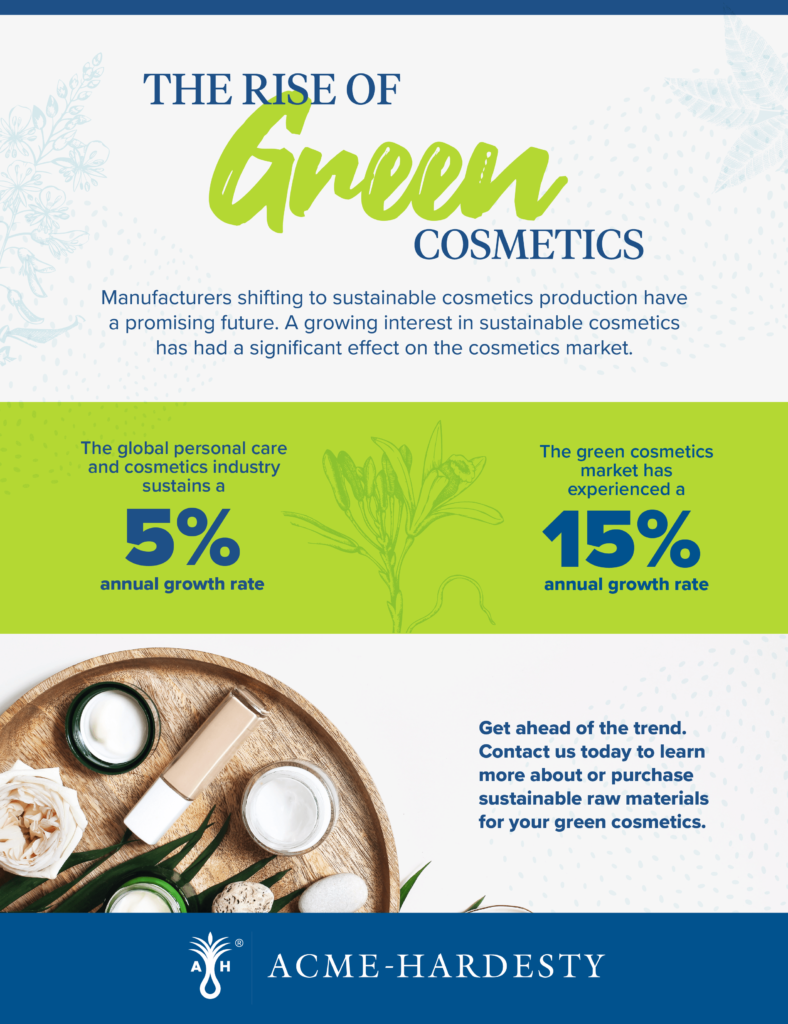
Manufacturing companies interested in venturing into the green market must know the details behind the sustainability movement, including the benefits of going green and the potential of the market.
What Are Green Cosmetics?
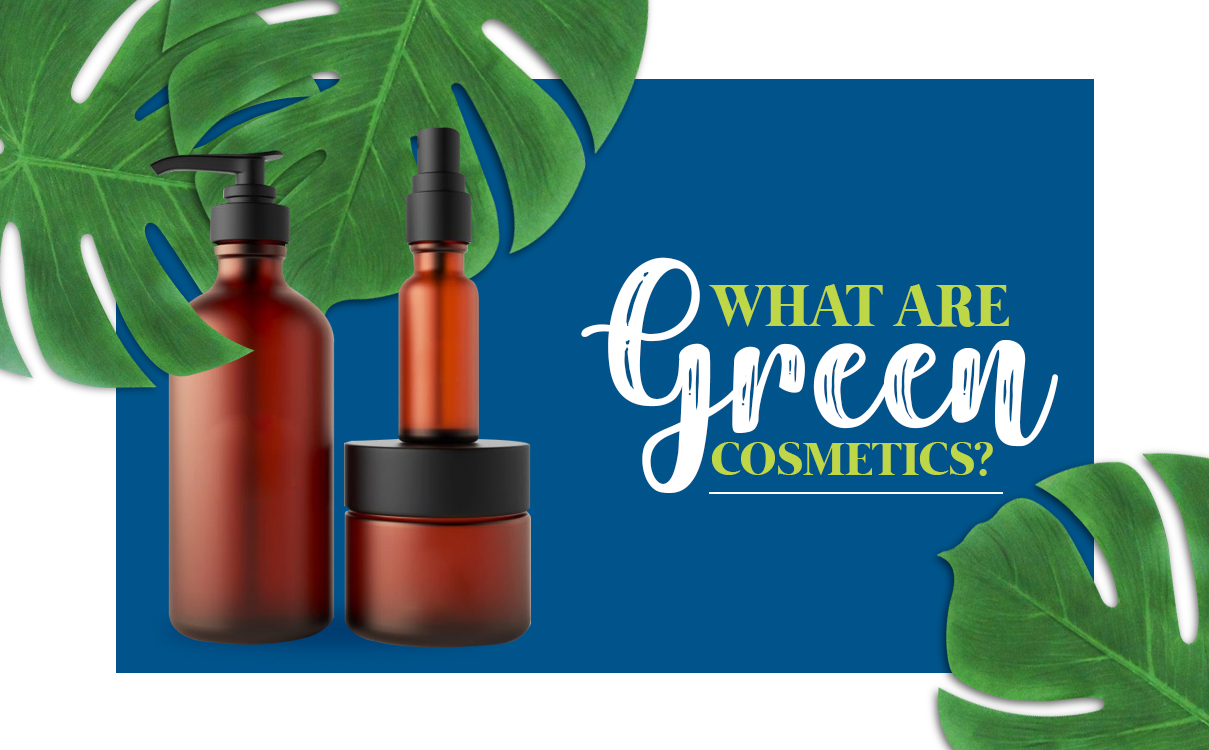
In modern marketing, the word “green” has become synonymous with “organic” or “healthy.” When a consumer sees the phrase “green cosmetics,” they will automatically make eco-friendly assumptions about the product or company.
But the field of green skincare and cosmetics still needs clarification. Typically, the term is used to describe products using environmentally-friendly formulations, production practices or packaging methods. In the United States, the Federal Trade Commission (FTC) has published guidelines to clarify what green or natural means in marketing terms, though these guidelines are still loosely defined.
With respect to the cosmetics industry, “green” and “sustainable” cosmetics are defined as cosmetic products using natural ingredients produced from renewable raw materials. Many companies use petrochemical ingredients derived from petrol, a non-renewable and economically volatile resource. Bio-based oleochemicals, on the other hand, derive from renewable plant and bacteria sources and are the crux of the green cosmetics movement.
How Are Sustainable Cosmetics Made?
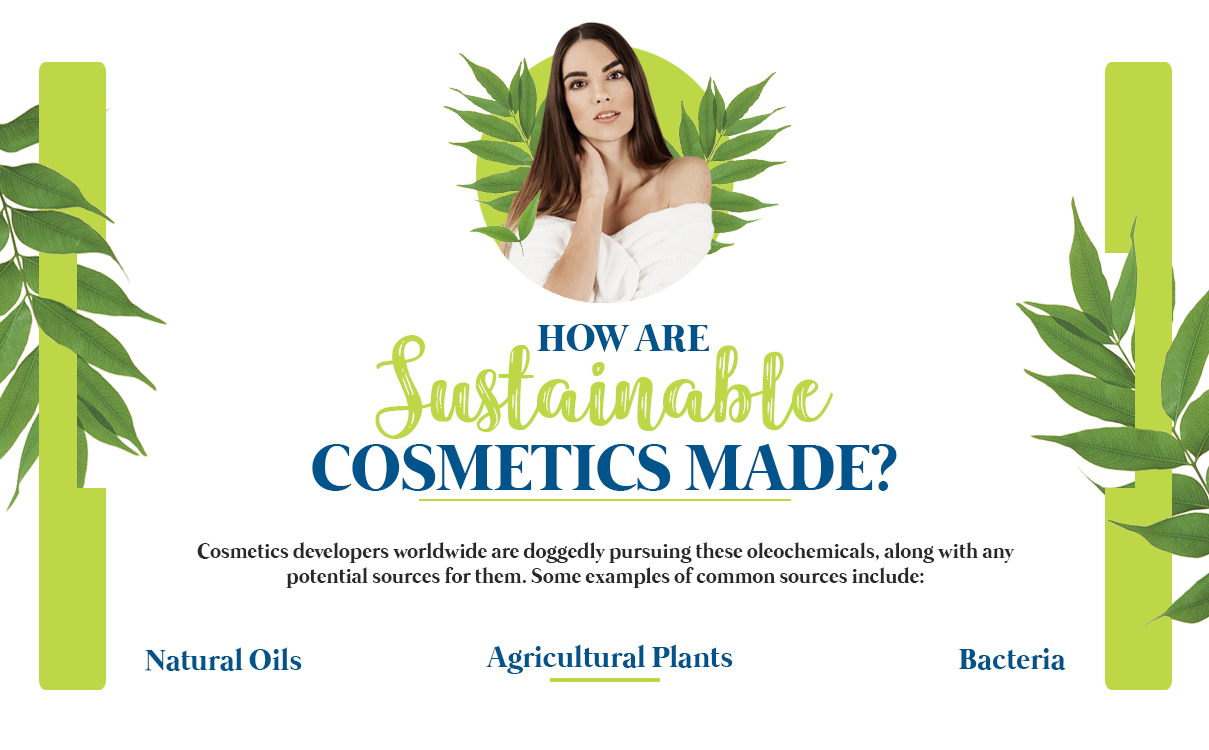
Cosmetics developers worldwide are doggedly pursuing these oleochemicals, along with any potential sources for them. Some examples of common sources include:
- Natural Oils: Palm and coconut oils are often used to derive fatty alcohols, which are used as chemical surfactants. Other oils include argan oil and avocado oil. Glycerine, a derivative of palm oil, is a common byproduct.
- Agricultural Plants: Soybeans, corn and other agricultural plants are used throughout the cosmetic industry to produce oils and alcohols. Green cosmetic emulsifiers, surfactants and biocatalysts are derived using these plants, which can be cheaply and sustainably sourced.
- Bacteria: One example of a renewable resource currently under development is the Deinococcus bacteria, a bacterium studied by Deinove in France for its chemical production properties. Deinove has used the bacterium to create aromatic ingredients and pigments for the cosmetic industry, representing a potential market value in the hundreds of millions of dollars.
Manufacturers split these raw materials into oleochemicals at a processing plant. The fats or oils are divided by hydrolysis, which uses water, or alcoholysis, which uses alcohol.
Ingredients That Aren’t Sustainable

By using natural, oleochemical sources, sustainable personal care products and cosmetics avoid many of the toxic elements found in popular brands. These chemicals damage environmental and human health, and consumers should never read them on a “green” label.
- BHA and BHT: BHA and BHT are synthetic antioxidants used as preservatives, and they are most common in lipsticks and moisturizing creams. The European Commission has released evidence that BHA and BHT disrupt the endocrine system.
- Coal tar dyes: On labels, coal tar dyes are listed as p-phenylenediamine or colors titled “CI” and followed by a five-digit number. These dyes are mixtures of petrochemicals, and they have been linked to cancer in humans.
- Formaldehyde-releasing preservatives: These preservatives are present in a wide range of cosmetics, as well as in cleaning products such as toilet bowl cleaners. As their name suggests, formaldehyde-releasing preservatives continuously release small amounts of formaldehyde, a known human carcinogen.
- Aluminum: Commonly used in antiperspirants, aluminum enters the body through the underarm tissue and blocks sweat ducts. However, it has also been linked to breast cancer, Alzheimer’s disease and osteoporosis.
- Dibutyl phthalate (DBP): Often found in nail products, DBP is a solvent for dyes. Considered toxic to human reproduction, it enhances the ability of other chemicals to cause genetic mutations. While Canada has banned DBP from all children’s toys, no action has yet been taken against its presence in cosmetics.
Examples of Sustainable Skincare and Cosmetics
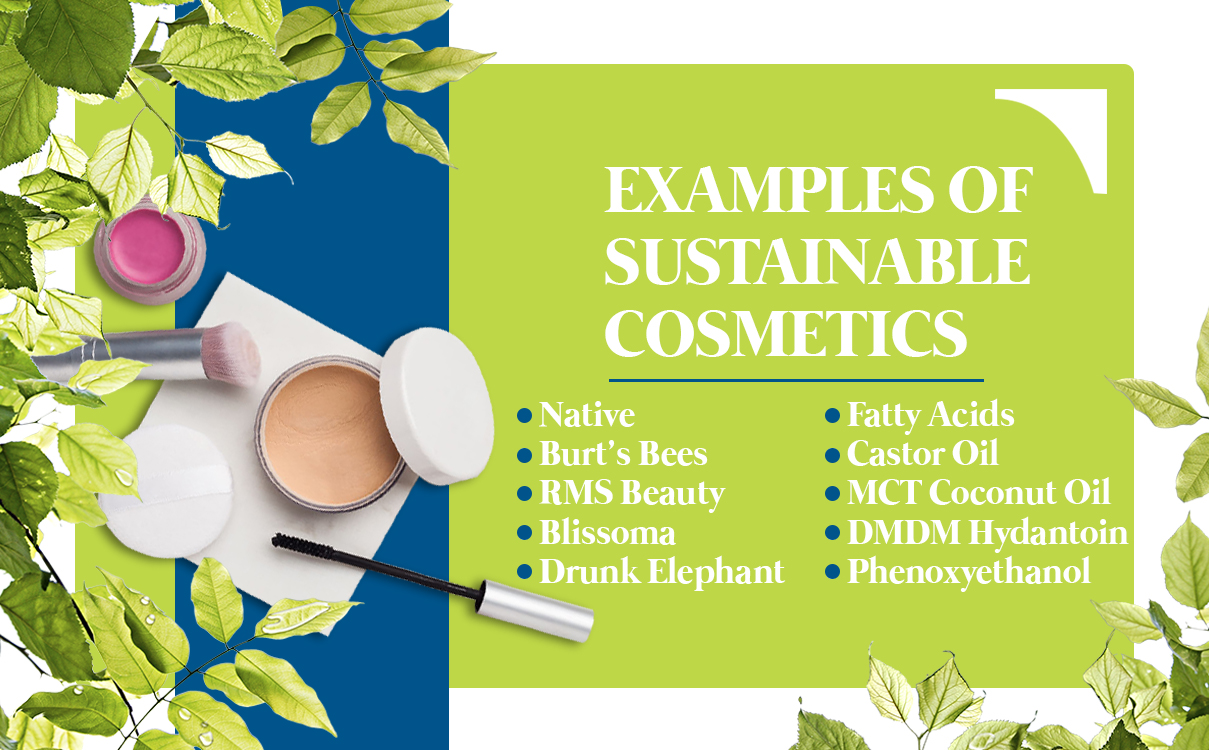
Many manufacturers have found success using oleochemical-based products, and beyond creating high-quality and effective products, they have gained a loyal customer following. Here are some of the most well-known, sustainable, green cosmetic brands and their products:
- Native: Native produces deodorants with organic, natural ingredients. Native has built their brand around “simple, nontoxic ingredients you can understand.” Their oleochemical-derived ingredients include shea butter, coconut oil and castor bean oil.
- Burt’s Bees: From simple beeswax candles to a lip-product empire, Burt’s Bees has become an international leader in sustainability. The company creates cosmetics and personal care products, and in addition to natural, organic ingredients, it has a “no-waste” manufacturing policy. They rely on botanical oils, herbs and beeswax to come up with their world-recognized products.
- RMS Beauty: RMS Beauty provides a wide range of cosmetics, from foundation to mascara. Dedicated to using organic ingredients, RMS creates non-toxic makeup products that heal and protect the skin. They use low-heat processing to ensure their ingredients remain as natural as possible.
- Blissoma: Focusing on skincare, Blissoma offers a large selection of green skincare products organized by skin type and need. Their preservative-free cosmetics include natural ingredients like fruit enzymes, Vitamin C and organic herbs and grains.
- Drunk Elephant: Committed to using clean, natural ingredients, Drunk Elephant manufactures a range of sustainable skin care products. They have a devoted consumer following and strive to create products that are both clinically-effective and naturally-sourced.
It’s possible for any company to incorporate green materials in their cosmetics. If you want to branch into the world of sustainable, oleochemical-derived products, begin with some of these safe and effective ingredients.
- Fatty Acids: Fatty acids like coconut fatty acid, stearic acid and oleic acid are green ingredients used as lubricants, adhesives and release agents, as well as emulsifiers and base stock. You can incorporate naturally derived fatty acids into a wide range of cosmetic products, including soaps, ceramic powders, lotions and creams.
- Castor Oil: Made by pressing the seeds of the castor plant, castor oil is a beneficial ingredient that has a range of anti-inflammatory and pain-relieving properties. When used in hair cosmetics, materials like Jamaican Black Castor Oil both remove impurities and clarify the scalp, resulting in more effective and more eco-friendly product.
- MCT Coconut Oil: Extracted from the kernel of mature coconuts, MCT Coconut oil is a highly specialized and versatile carrier oil. Light, smooth and easily absorbed into the skin, MCT oil is especially useful in skincare products. Because it doesn’t leave an oily residue, MCT oil is ideal for products marketed as oil-free or for sensitive skin types.
- DMDM Hydantoin: A powerful antimicrobial agent, DMDM Hydantoin is a halogen-free preservative. This eco-friendly ingredient can be added to both rinse-off and leave-on products, including eye and skin creams, shampoo and conditioner, sunscreen, liquid soap and make-up remover.
- Phenoxyethanol: Inhibiting both bacteria and mold growth, phenoxyethanol is an effective preservative used in a wide range of green cosmetics, from lotions and creams to make-up and gels. Phenoxyethanol serves a variety of roles within cosmetics, including solvent, fixative and topical anesthetic functions.
Committed to sustainable manufacturing, Acme-Hardesty offers each of these green ingredients for manufacturers in the cosmetics industry.
Why Buy Natural and Sustainable Cosmetics
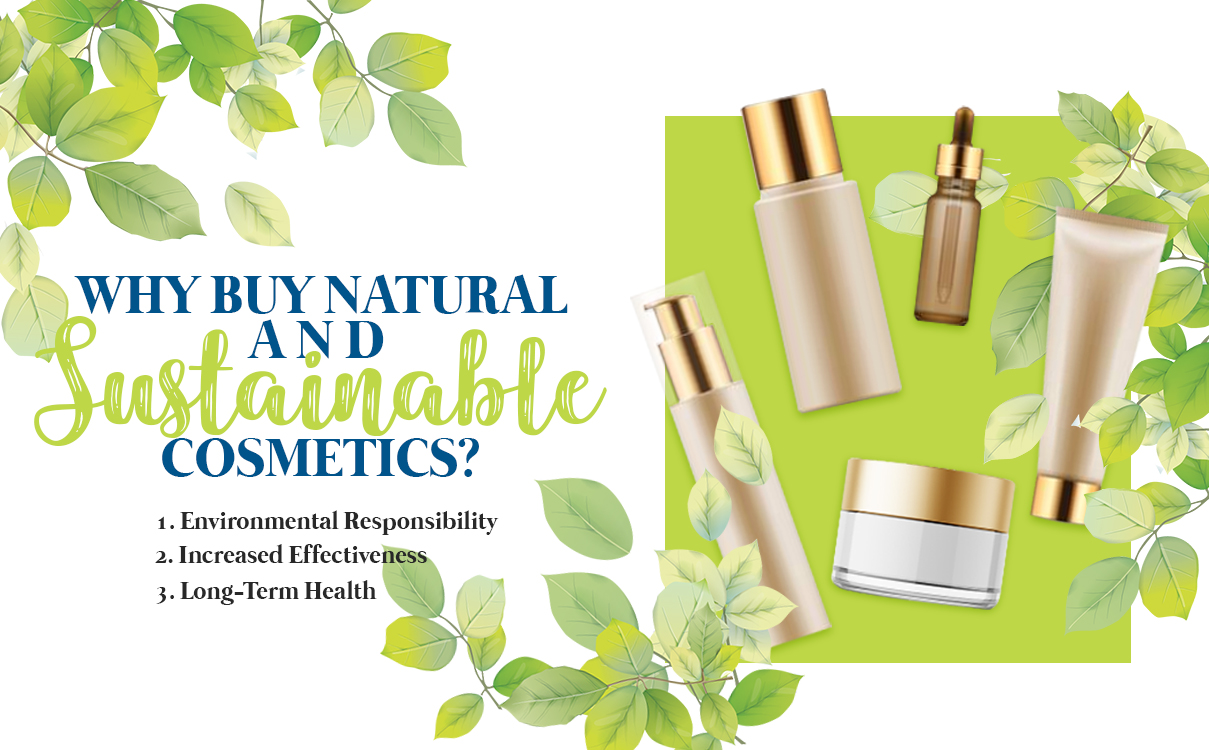
For the consumer, the attractions of sustainable cosmetics outweigh extra costs or research. Three major draws of green cosmetics include environmental responsibility, increased effectiveness, and long-term health.
1. Environmental Responsibility
Modern consumers have a growing global consciousness, and they care about social and environmental responsibility. One of the main benefits of sustainable products is their kinder environmental impact.
Every week, new stories surface about dangerous carbon outputs or vast plastic floats in the ocean. Many petrochemicals in conventional cosmetics are toxic pollutants and degrade the environment as well as our bodies. As we become more ecologically aware, consumers demand natural, low-polluting products.
A recent example of pollution and consumer demand is the ban of microbeads. Microbeads are tiny pieces of plastic found in many shower scrubs and exfoliating products. However, they do not dissolve, and in 2015, a study reported that over eight trillion microbeads were being washed into our waterways every day. Later that year, U.S. President Barack Obama signed a bill banning the small plastics, illustrating that environmental stewardship is an increasing priority to the nation and its consumers.
2. Increased Effectiveness
Natural and oleochemical ingredients are less likely to cause skin irritation or allergic reactions. Without synthetic, toxic chemicals or artificial colors, sustainable products rely on the healing properties found naturally in plants and animals — the ingredients humans have been using for centuries.
Consider glycerine, a natural derivative of palm oil. The clear, non-toxic liquid is used in soaps, pharmaceuticals and cosmetics. Since it is a humectant, glycerine can retain water, making it an excellent moisturizer. Glycerine enhances the body’s hygroscopic characteristics, encouraging the skin to absorb and hold on to water. As a non-irritating substance, it can be applied anywhere on the body. It is an effective anti-aging ingredient and, due to its anti-microbial properties, can also serve as an acne treatment.
An oleochemical that has all the power of synthetic chemicals without any of the toxicity, glycerine is a perfect example of the natural effectiveness of sustainable cosmetics.
3. Long-Term Health
While petrochemicals may deliver short-term results, the long-term effects can be highly toxic to humans and the environment. Years of synthetic cosmetics use has been traced to headaches, eye damage, acne, hormonal imbalance and premature aging. Phthalates have even been linked to cancer and type II diabetes.
By choosing sustainable cosmetics, a consumer forgoes the stress and uncertainty of toxic, synthetic products and invests in their long-term health and beauty.
Why Produce Green Cosmetics?
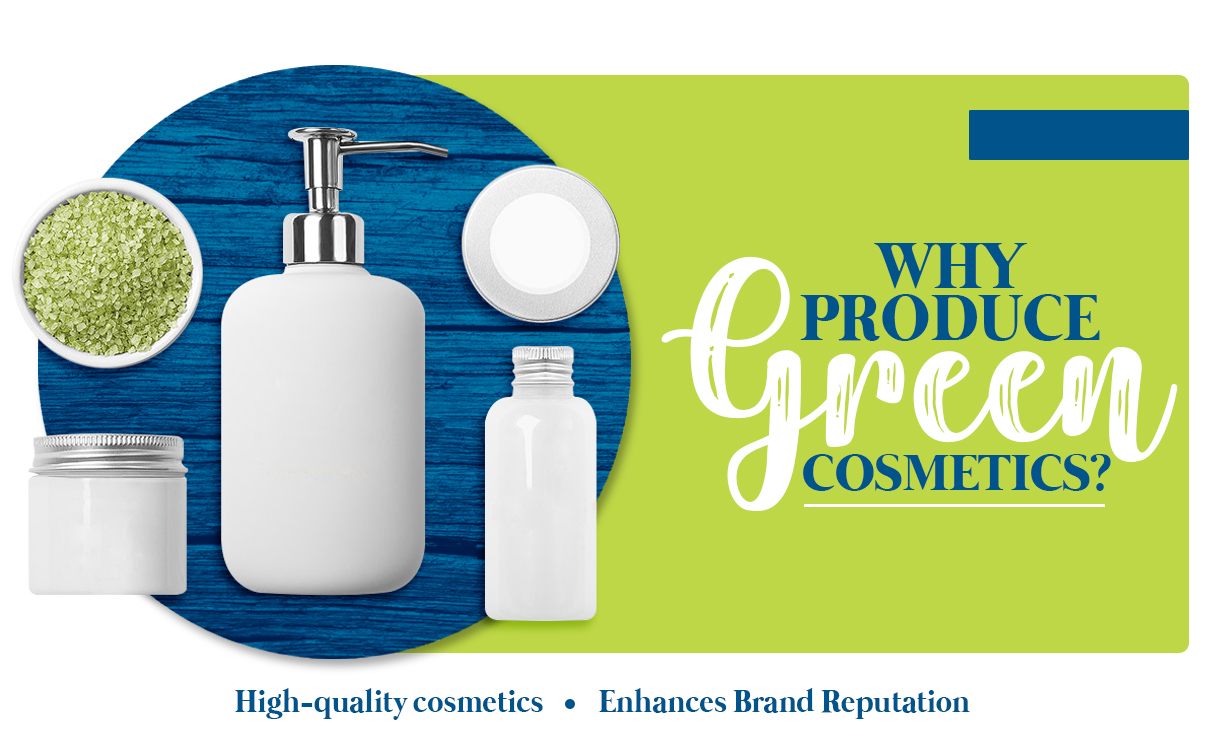
Creating environmentally-friendly products doesn’t mean sacrificing quality or profits. With the public eye increasingly focusing on corporate ethics, small steps toward sustainability can significantly improve public opinion and boost sales.
1. Improved Product Quality
High-quality cosmetics provide effective results without putting the consumer at risk. However, many petrochemical products, like mineral oil, present a low level of toxicity to users. When aerosolized and inhaled, such products have been shown to be allergens and, as some studies suggest, may cause cancer.
With most bio-based products, the toxicity to the end-user is reduced, creating safer, higher-quality products.
2. Enhances Brand Reputation
Green products send a message to consumers — this company is committed to quality, safety and sustainability, and is worthy of your trust.
As more and more people grow concerned about synthetic products, consumers are looking for companies that practice transparency and honesty. By moving towards sustainable, green products, you show your global and social awareness. This promotes customer loyalty to a brand, not just to products. People will begin — and continue — to purchase a company’s products because they agree with its mission.
3. Increases Corporate Responsibility
Green cosmetics also present a unique opportunity for cosmetics manufacturers to focus on corporate responsibility. In addition to the positive impacts green marketing can have on a company’s image, taking the extra steps of sustainable sourcing or packaging can also make a significant impact.
When a company increases its sustainability initiatives, it takes ownership for its impact on global health and economies. By taking corporate responsibility for its manufacturing, a business gains authority and respect among consumers as well as suppliers and other members of the distribution chain.
The Future of Sustainable Cosmetics
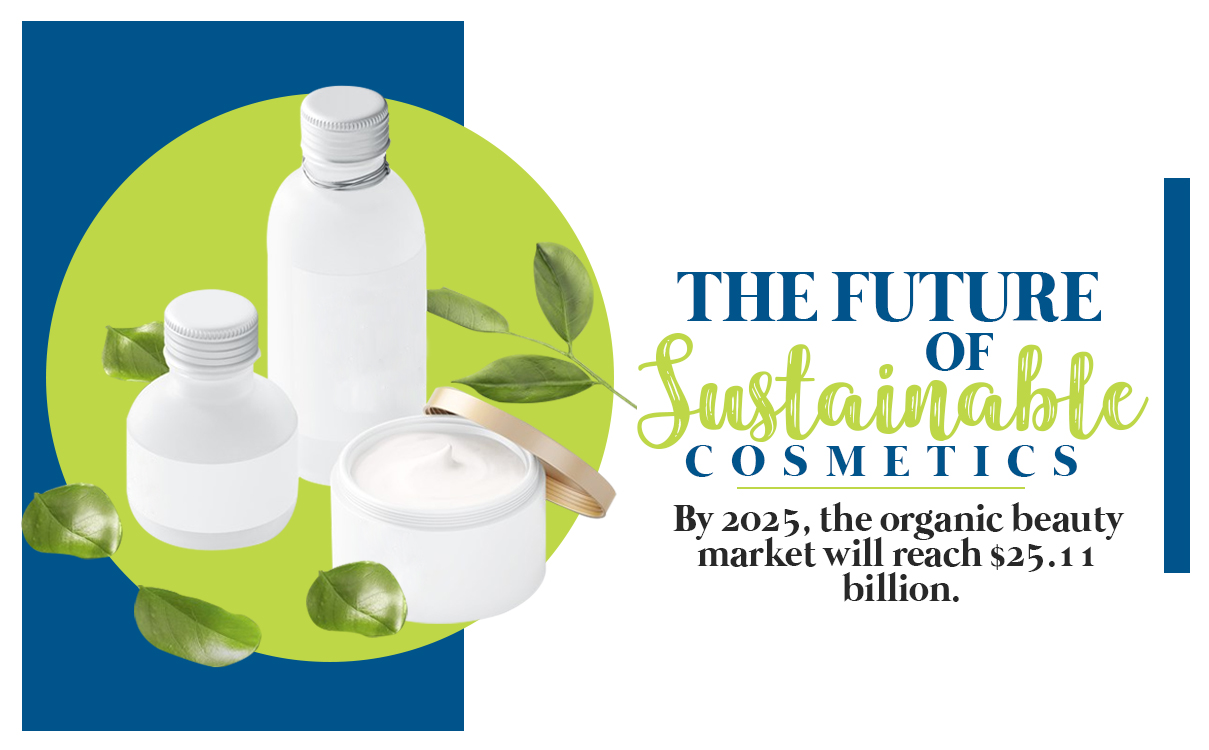
Manufacturers shifting to sustainable cosmetics production have a promising future.
The growing interest in sustainable cosmetics has had a significant effect on the cosmetics market. With an increasing number of consumers and retailers demanding cosmetics with natural or sustainable ingredients, the green cosmetics market has experienced a 15 percent annual growth rate.
This growth rate far outpaces that global personal care and cosmetics industry, which is currently sustaining an overall 5 percent annual growth rate. By 2025, the organic beauty market will reach $25.11 billion.
Within the personal care industry, the oleochemicals market is increasing as cosmetic manufacturers continue to turn away from petrochemicals. Fatty acids, in particular, should experience boosts on the green side of the market, considering that they accounted for 57 percent of the total oleochemical product demand in 2013.
The Asia-Pacific region is an area of particular interest for this market since the region accounted for 41.9 percent of the total oleochemicals market in 2013 for its abundance of raw materials and large consumer base. Both figures are unsurprising considering the quantities of bulk cosmetic glycerine regularly exported from the region.
Start Going Green

As petrochemicals continue to experience volatility in the market, turning to sustainable material sources may be the best long-term decision for cosmetics manufacturers worldwide.
Consumers are increasingly demanding sustainable products that are not toxic to themselves or the environment. The natural market is growing exponentially, and choosing raw, natural materials will cement your brand as a safe choice — both environmentally and economically.
For more than 70 years, Acme-Hardesty has been leading innovation in oleochemicals, palm derivatives, preservatives, surfactants and castor oils and derivatives. As one of the largest distributors of these products, we work with manufacturers in multiple industries, expanding into bio-based and renewable solutions to give customers more options.
Contact us today to learn more about or purchase sustainable cosmetic raw materials.
